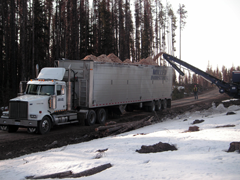
Ask people in British Columbia's timber towns how to reverse their plummeting fortunes and a lot of them will say the solution begins at home -- with locals gaining control of how nearby forests are put to use.
Too much of B.C.'s most valuable resource is in the hands of a few corporations with faraway headquarters and no incentive to reinvest in a diversified economy for rural B.C. When those big firms pull the plug on a B.C. operation, local employees often are among the last to know. The province needs to get creative about helping small forest communities take more control of their fates.
That's the message this reporter heard often during a recent journey through Prince George and nearby communities hard hit by mill closures and pest devastation.
One of those towns is Burns Lake, which sits at the approximate geographic centre of the mountain pine beetle epidemic in B.C.
'Community forests' the future?
Burns Lake, population 2,000, is worth watching as an example of what a difference local management of forests can make, because it is surrounded by the largest "community forest" in the province.
At 85,000 hectares, the Burns Lake community forest has more than tripled in area since it was created in 1998. That was the year the province introduced its community forest pilot program.
The program, which has grown and changed over the past decade, grants area-based tenure to communities and First Nations, allowing them to harvest and manage forests for community economic and environmental benefit.
Alistair Schroff, general manager of the Burn Lake community forest, has spent the past few years trying to figure out the new forest economy.
Could turning salvaged beetle wood into biofuel be the best way forward? Or would it be more sustainable to find ways to add value to logs through milling and manufacturing?
Biofuel's iffy future
The hauling distances associated with getting wood waste out of the bush create expenses that are, so far, the big stumbling block to wood-fuelled bioenergy thriving in B.C. But Schroff says there's no choice but to experiment. "We don't know what the winning techniques are, but we know we have to do something...it's just trying to learn our way through it," he says.
Right now, a local contractor is at work in the Burns Lake forest just south of Decker Lake, grinding up roadside piles of timber. The resulting chips are trucked to a pellet plant 80 kilometres away in Houston.
"This will extend our ability to go in and recover value and get those stands back into production," says Schroff.
"But our internal calculations suggest in three to seven years we would have a significant drop in what we're doing here" as the beetle-killed wood diminishes.
"And, really," says Schroff, "our land can produce a lot higher value material rather than raw fuel."
Competing with the big firms
Some of the highest value products are lumber products like wood siding, panelling and moulding -- basically, "anything that is not a smoothly planed rectangle," says Russ Cameron, president of the Independent Lumber Remanufacturer's Association.
The association represents 82 small companies, anywhere from 10 to 100 employees, across the province. Five years ago, membership was 120 strong.
"Our guys have taken a beating," says Cameron, noting that 83 former members have since gone out of business.
Cameron says the group was averaging $2.5 billion in sales in 2003, which has decreased about 30 per cent. The two biggest problems, he says, are conditions of the softwood lumber agreement that penalize domestic remanufacturing, and the fact that most timber is tied to a few major license holders.
Cameron says the B.C. timber sales program -- essentially an open market for timber -- is good, but smaller manufacturers can rarely outbid large companies like Western Forest Products or Canfor.
"There's no way you can bid against them," he says. "We don't have the time, the money, the expertise, the desire...we just want some lumber."
Remanufactures primarily get lumber from private woodlot owners, says Cameron, but he sees potential for more partnerships with community forests as well.
"It's a big undertaking for municipalities to get into logging, but as they develop, in my view, there will be some good partnerships to come out of that."
Community forests 'not really on radar'
Jennifer Gunter, co-ordinator of the B.C. Community Forests Association, says community forests have increased in number over the past couple of years, since the provincial government doubled the total annual allowable cut for these types of tenures in 2003.
There are currently 43 in the province right now, operated by municipalities, First Nations and community organizations.
"Most people don't really know about community forests. We're not really on the radar much here in B.C.," says Gunter.
Gunter says the association is currently working on a guide to non-timber forest products such as plant pharmaceuticals, mushrooms, berries and eco-tourism.
"Because they're a form of forest tenure, they've had to be very focused on timber harvesting. But as time goes on, there's more and more interest in diversifying and trying to figure out ways to survive into the future, particularly the ones that are in mountain pine-beetle affected areas."
'Keeping the community alive'
The Cheslatta Carrier First Nation (CCN), located about 50 kilometres south of Burns Lake, also holds a community forest license that supports one mill jointly owned by the CCN, the non-Native community of Ootsa Lake and Carrier Lumber Ltd.
Last December, the CCN signed a memorandum of understanding with bioenergy developer Pristine Power, paving the way for Pristine to build a 10-megawatt gasification plant that will feed off this mill's residue as well as nearby logging wood waste.
Mike Robertson, senior policy advisor for the CCN, says council had been looking for an alternative use for its mill waste -- 80,000 tonnes of which is currently incinerated in a beehive burner -- for 15 years.
Their mill currently runs on diesel generators, and operating costs have increased by $1 million in the past six months alone, says Robertson.
"Keeping the community alive is what we're all about. If we can break even for 25 or 50 years, we're incredibly successful, and that's our goal."
If there's a lesson to be taken from such efforts to get the most out of wood waste, argue experts, it's that diversification is key. And in this new forest economy, smaller community operations are better positioned to pull it off.
But not without key changes at the government level, say some experts, who point out that the success or failure of smaller community operations to adapt to a changing economy still hinges greatly on provincial forestry policies and trade agreements.
Beyond the next few decades awaits a new set of challenges for B.C.'s forest communities. Richard Hebda, the curator of botany and earth history at the Royal B.C. Museum, says to expect more pests, more fires and fewer trees – changing the way the forest can be used as a resource.
"Community forests, with good scientific, scholarly advice, wide-open discussion and council participation, have a great opportunity," says Hebda.
"At a provincial scale, we need to change the way the tenure system enables new innovations to go forth. We have to take action now."
Related Tyee stories:
- Burn Trees to Light Homes?
Europe imports BC wood pellets to create 'bioenergy.' Here, it's not so easy. - Who Will Revive BC's Forests?
World relies on our 'lungs,' but replanting is lowest in 20 years. - BC's Crazy Timber Economics (series)
Read more: Labour + Industry, Environment















Tyee Commenting Guidelines
Comments that violate guidelines risk being deleted, and violations may result in a temporary or permanent user ban. Maintain the spirit of good conversation to stay in the discussion.
*Please note The Tyee is not a forum for spreading misinformation about COVID-19, denying its existence or minimizing its risk to public health.
Do:
Do not: